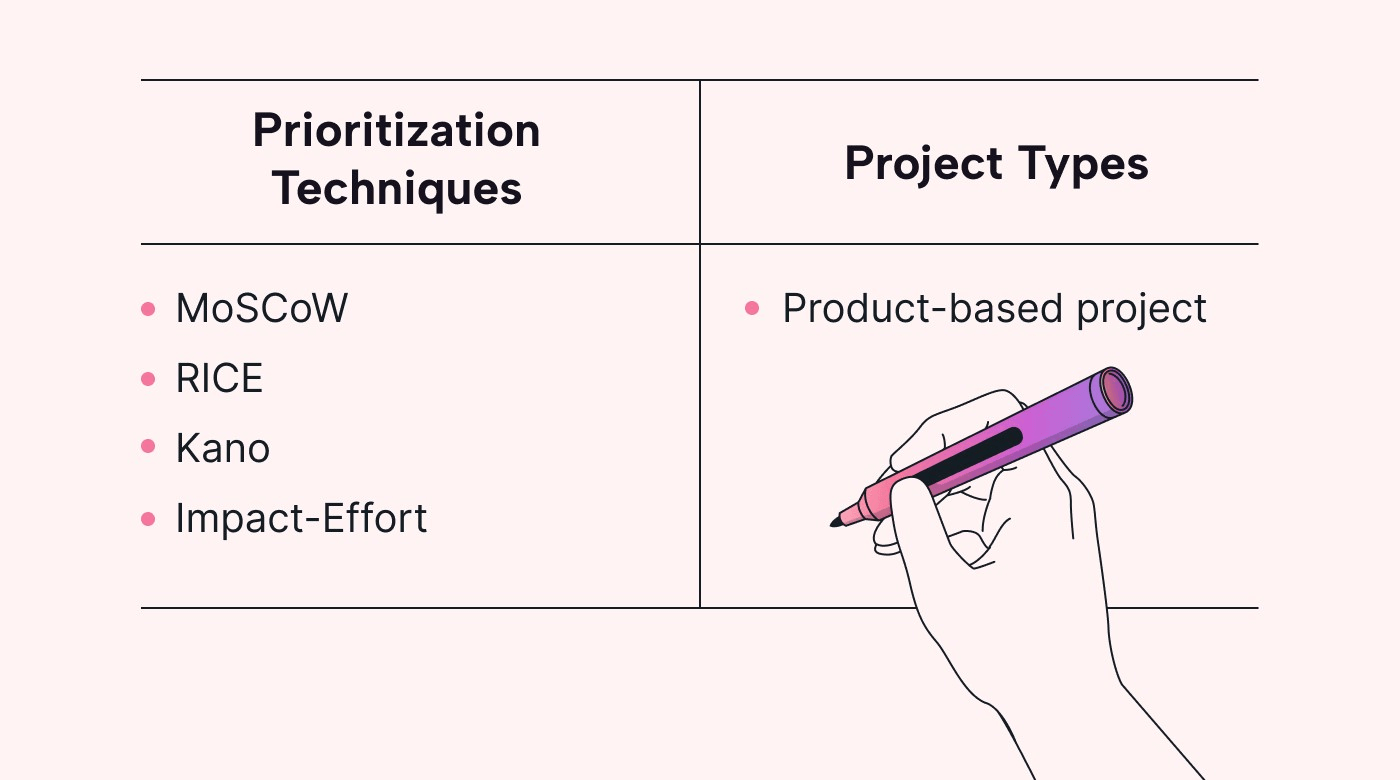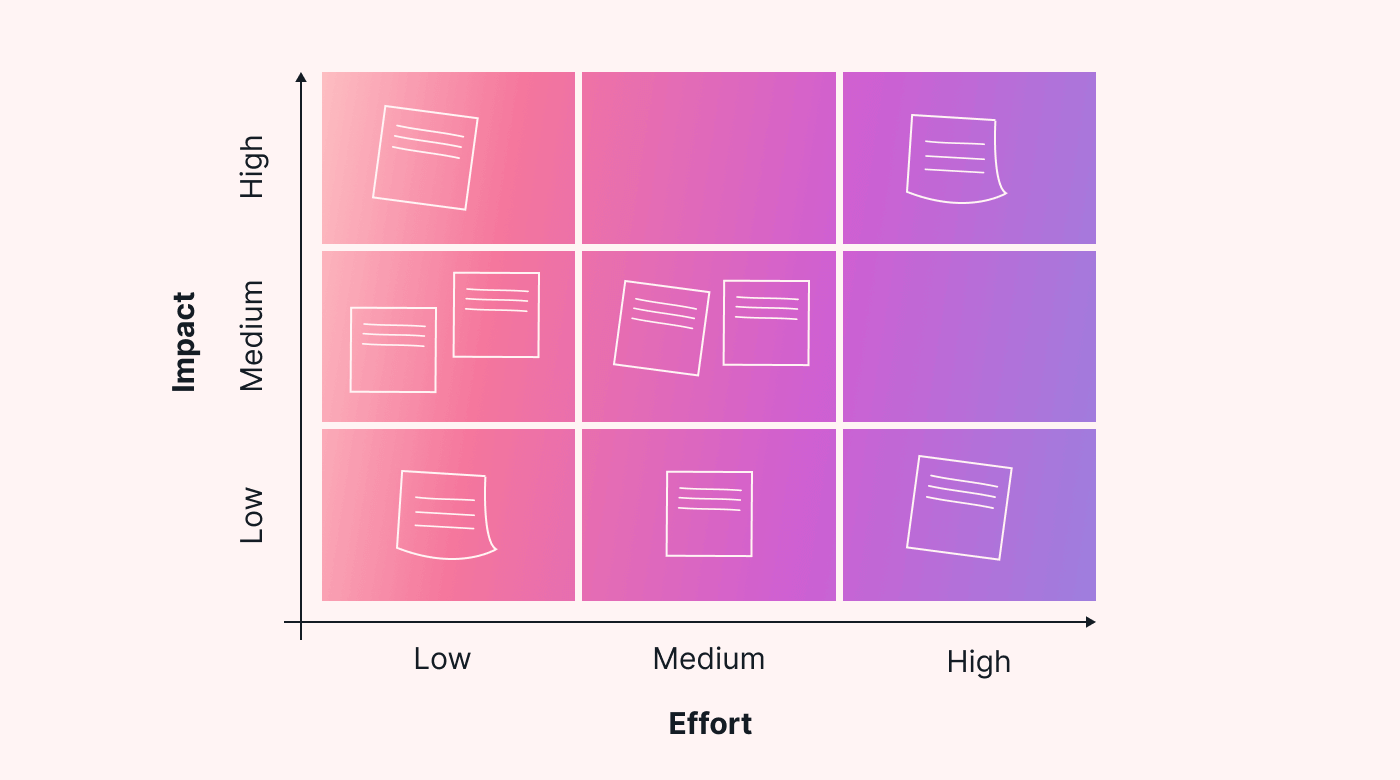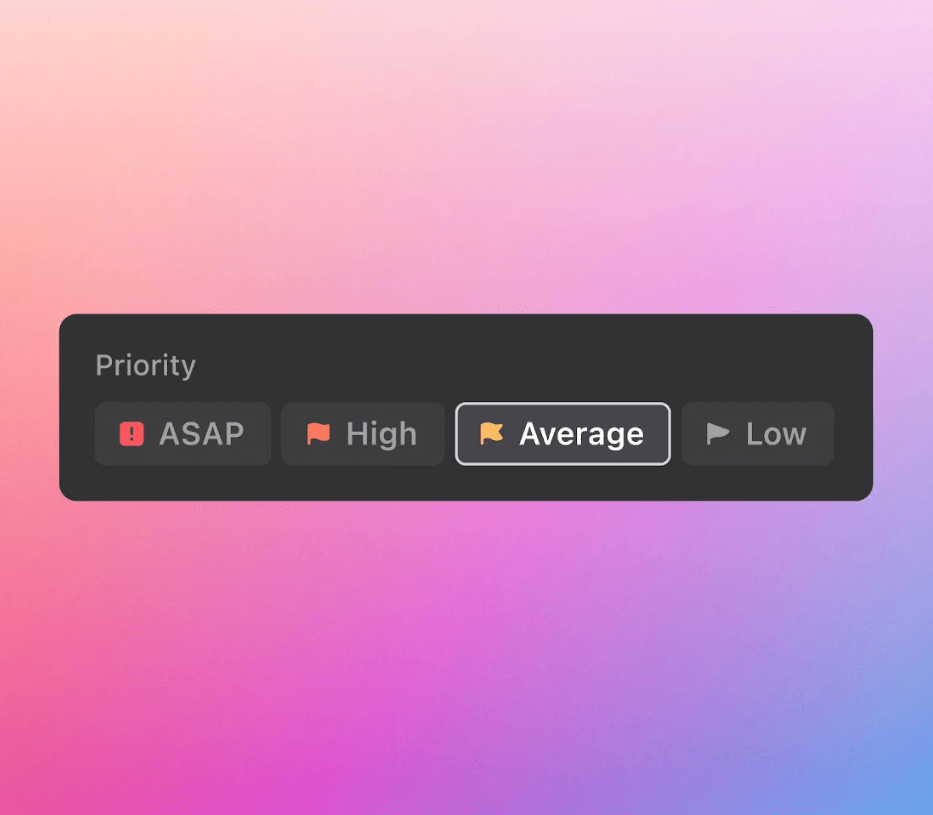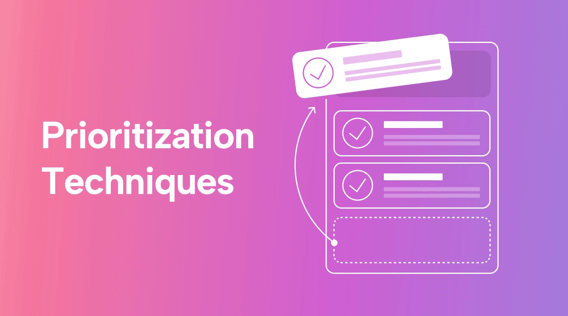Project managers work in fast-paced environments. Most manage up to 5 projects simultaneously, and 15% juggle ten projects at the same time. The resulting complexity makes it difficult — and even impractical — to pick one go-to prioritization technique.
But we’re here to tell you a secret: you can change things up.
Think of it this way — a customer-focused project will benefit from a different strategy than a technical IT project, and a product-based project might require a third option. Ultimately, every project is different. As such, you should choose the technique that works for the project in front of you to generate the best results rather than sticking with one golden prioritization method.
Let’s dig into four of the best prioritization techniques and how to pair them with common project types so you know how to choose the right method for your project.
4 effective prioritization techniques and when to use them
These four are tried-and-true prioritization methods you want in your bag of tricks. They’re easy to use and applicable to various situations and Agile methodologies.
- The MoSCoW method
- Rice scoring
- The Kano method
- The Impact-Effort matrix
 |
Let’s look at how they work and when to use them.
The MoSCoW method and product projects success
Are you working on a minimum viable product (MVP) project? An MVP is a product that has just enough features to meet the needs of early users. The goal is to release the product and use feedback from early customers or users to shape the future of the product.
These projects can be tricky to prioritize because getting to that first rollout of the product is paramount, and it’s easy to blow out timelines by overbuilding requirements for launch. The MoSCoW method makes a lot of sense for these projects because it leads you in the right direction for acceptance criteria for product definition and features.
“MoSCoW” is an acronym for the following requirements: most important to least important.
Must have:
List requirements critical to your project that must be delivered by the deadline. These are the bare minimum requirements to meet the basic needs of the product's first users.
Should have:
These requirements are important but not urgent to deliver at the launch deadline. Think of these as requirements you can be flexible with, either squeezing them in if there’s room at the end of the timeline, or lining them up for the first post-launch update.
Could have:
These product features are not strict requirements but rather “nice to have” if the parameters of the project (budget, staffing, timeline) allow. These requirements can be planned out with scheduled updates throughout the product's life.
Won’t have:
These requirements or features won’t be delivered in the first iteration or phase of the project, but they are captured for potential delivery at another time or during the following phase. These requirements can stay in the product backlog indefinitely.
RICE prioritization is great for technical projects
The RICE method prioritizes projects, tasks, or initiatives based on their potential impact, required resources, confidence level, and effort involved. This technique works well for projects with technical tasks that can be well-defined, like back-end work carried out by developers for an app.
This work may not have visual components or design, but the importance of requirements can be measured and thus properly prioritized by considering the following criteria and following the simple and easy formula of the RICE method.
Reach
The size of the potential audience, or users, who will be affected. This could be internal teammates, like content editors, who need a streamlined workflow.
Impact
The measure of the potential benefit or value. If this project will affect internal content editors, the impact could be an estimate of time and effort saved by having an improved workflow. That could look like budget and timeline savings and freeing up editors to work on other projects.
Confidence
Confidence is based on research. It’s the level of certainty in the data used to assess reach and impact. The steps to change the workflow should be well documented, researched, and shown to be a viable plan.
Effort
The estimate of the resources and time required to complete the project or task. In this example, the developers should have a good estimate of how much time they need to invest to implement the backend changes needed to update the editing workflow.
 |
Calculating the final score
To find your RICE score, multiply the reach, impact, and confidence scores, then divide the result by the effort score. The higher the RICE score, the higher the priority of the project or task.
Pair the Kano model with UX projects
Noriaki Kano invented the Kano model. It puts customers and users first by analyzing their emotions across five quality categories, making it perfect for UX-focused projects. You may have heard of it if you know the Six Sigma framework.
This technique is about prioritizing improvements to the user’s satisfaction and saving time by not focusing on anything that doesn’t keep satisfaction front and center.
Must-be quality
Identify what customers expect automatically. These are the most important features to capture because they set the standard for the user’s experience and ensure that basic functionality is met.
One-dimensional quality
Take note of what makes a difference between customer satisfaction and dissatisfaction. This will guide what tasks the team decides to tackle first.
Attractive quality
What ensures that the customer is satisfied? This quality is about building delight or excitement into a product or experience. Your project will want to home in on these tasks.
Indifferent quality
Some features don’t increase or decrease the client’s satisfaction; it’s important to call these out so the team doesn’t spin their wheels on features that won’t impact how users feel.
Reverse quality
Finally, it’s critical to capture what causes a major level of dissatisfaction among the customer. Sometimes, these will be the highest priority tasks because they will quickly solve existing pain points to provide value.
The Impact-Effort matrix helps with discovery-heavy projects
For those squishy projects that need lots of definition and discovery, an Impact-Effort matrix might be just the thing to prioritize goals or individual tasks. It is a compelling visual highlighting the relative user value against implementation complexity.
This matrix tool welcomes analysis, discussion, and discovery while helping identify areas that may require high investment in research, definition, and even budget.
 |
Impact
On one side of the graph, you’ll plot where a goal or task lies in impact on a low, medium, or high scale.
Effort
On the other axis, you’ll see how much effort will be needed to achieve a goal or task on a low, medium, or high scale.
Depending on the project's parameters, like scope or timeline, investing more time in discovery around high-impact but high-effort tasks with a higher budget might make sense.
Conversely, with a tight budget or limited resources, your project may benefit from prioritizing higher-impact but lower-effort tasks.
This prioritization technique will help you know where to spend time wisely with discovery and research. It can also help determine when planning for future releases of essential features becomes necessary.
Other prioritization techniques you can try
There are lots of other effective prioritization techniques you can incorporate into your practice.
- The eat the frog technique is great for prioritization beginners. This time management technique helps you plan tasks for the day with task clarification, planning, applying the 80/20 rule, and being aware of the consequences.
- The Eisenhower Matrix is a visual 2x2 grid similar to the Impact-Effort matrix. Each square represents a different level of priority: Important and Urgent, Important and Not Urgent, Not Important and Urgent, Not Important and Not Urgent. Use this tool for projects with smaller task lists to help you decide which task needs your attention first.
- Use ABC Analysis for an even more straightforward technique when time is of the essence on projects with tight deadlines. Grade tasks like you would a school quiz: “A” tasks are top priority, “B” tasks are important but not as urgent, and “C” tasks are the least important tasks to carry out.
- Making a feasibility, desirability, and viability scorecard can help prioritize items in projects requiring a lot of roadmapping or discovery. Create a table laying out items or tasks with scores of 1 to 10 for feasibility, desirability, and viability criteria. Total the scores, and the items with the highest overall scores best indicate priority.
When deciding on a technique, remember the most restrictive constraints of the project at hand, which could be a tight scope, short timeline, or strict budget. Don’t be afraid to experiment, and remember that using the right tools, like Motion, can make any technique effective.
Motion automatically plans which tasks team members should work on first. It can also organize your projects for you, freeing up your time and mental energy for more important tasks.
Which technique will you choose?
Choosing the right prioritization technique is all about considering the unique project in front of you. With a solid understanding of these four important techniques, you can determine the right strategy for project success.
Next, strengthen your technique with technology.
 |
Motion’s Intelligent Calendar and Task Manager work together to prioritize and add tasks to the schedule to ensure your team completes everything by the deadline. You can try it out with our 7-day free trial.





